Nettlebed Community -

!
We regularly update this section with new content
Do keep visiting. Suggestions for additional items always welcome
Nettlebed -
Compiled by Jeff Reynolds c2004
Edited by Malcolm Lewis 2013
The origin of the name Nettlebed is unknown. There are various theories. One is that Roman soldiers in the 1st and 2nd centuries AD rubbed nettles on their limbs to keep warm on marches. Another well known fact is that nettles yield a thread which can be made into a linen cloth. Many homes at the end of the 18th century had sheets and table cloths made from nettles which grow in abundance around the area. Nettlebed remained part of the manor of Benson until the late 13th century hence it was not mentioned in the Domesday Book which was a record of the ownership of manorial land.
Nettlebed has been an inhabited area for centuries and many middle Stone age implements found in earthworks in a Highmoor trench are now in the Ashmolean Museum in Oxford. At Digberry farm there are little-
Nettlebed was of some importance in ancient times because of its position on the point where the Henley -
Karl Philipp Moritz, a German pastor travelled though England mainly on foot in 1782. On his journey from London to Oxford and further north he had intended to stop in Henley but decided it was too fine for him. He was obliged to walk on and reached Nettlebed in the dark. Many foot travellers were not always well received in those days but he was made so welcome in the village he stayed for another day and night and resolved to return to his "favourite" place. His account of his time in Nettlebed runs into several pages in his book "Travels in England in 1782 " which is available online in English and in German and well worth reading.
Nettlebed Past and Present -
Go to VICTORIA COUNTY HISTORY for more history of Nettlebed
(link removed awaiting update from VCH in late 2016)
Nettlebed was fortunate in having a rich supply of the clay suitable for brick making that ran in a vein through the Chilterns.
The clay has been in use for 800 years by potters and brick makers for making pots, pans, clay-
England's world renown for table glass developed only after 1674 when George Ravenscroft evolved a new formula and with this was able to make "the finest and noblest glass", then called flint glass, and now known as lead crystal. This glass was made in Henley after certain sand sent from Nettlebed enabled Ravenscroft to change his formulas and produce the beautiful examples of glass still in existence. A goblet with his seal c1675 produced from Nettlebed sand is pictured here.
Token coinage was issued in Nettlebed in the 17th century after the English Civil War.
In more recent times inhabitants of Nettlebed worked in the village, there being many forms of employment. The big house -
The Fleming family's involvement with Nettlebed began in 1903 when Robert Fleming, the Scottish banker, bought Joyce Grove, where a house had stood on it’s present site for many centuries, together with 2000 acres of farmland, woodland, common, pottery and brickworks and many of the cottages. He came to an agreement with the village cricket club under the new Nettlebed and District Commons (Preservation) Act 1906 to remove their ground close to the entrance of Joyce Grove in return for a new ground on three acres of land reclaimed from the nearby clay excavations, including a pavilion. In 1908 he commissioned the architect C E Mallows to design a completely new house in the Jacobethan style in red brick with Bath stone dressings. Robert Fleming died in 1933 and in 1938 his family gave Joyce Grove and it’s grounds to St. Mary’s Hospital, London. It was used for training nurses and as a convalescent home during the Second world War. It is now a Sue Ryder Care Home. In 1909 Robert Fleming established the merchant bank Fleming and Company. Many of the Fleming family are laid to rest in Nettlebed churchyard. Col. Peter Fleming the well known traveller and writer and his wife Dame Celia Johnson are amongst them.
The current members of the Fleming family live locally, run the Estate and take an active part in village life.
Fleming’s grandson was the renowned travel writer Peter Fleming and whose younger brother was the celebrated spy novelist Ian Fleming, who wrote the James Bond books.
Peter Fleming married in 1935, the actress Celia Johnson, who starred in the classic British film “Brief Encounter” of 1945.
Nettlebed Village Club was known until recent times as the Working Men’s Club. The building has changed little since 1913 when it was officially opened. It was also designed by C E Mallows in his more familiar Arts and Crafts style and is said to be one of the best examples of the genre in Oxfordshire. The building contained a wide range of village activities including a rifle range, skittle alley, billiard room, cinema, dance floor and bar. The latter was only allowed to be used by women on Christmas Eve!! Today the club has a lively member’s bar and the two halls are used for a wide range of village activities.
Village Club and Hall History
Nettlebed was also very well provided for in times gone by. It was not necessary to leave the village for goods and services. The White Hart Hotel is now the only remaining hostelry. In the past there were also the Nags Head, Red Lion, Cross Keys, Bull, Sun Inn, Fox and Hounds and Carpenters Arms at Crocker End. Shops included cobbler, two bakers, butcher, cycle, petrol and repair garage, grocer/haberdasher, hardware, pharmacy, cafe/post office, blacksmith and farrier as well as men's, women's and children's clothing and shoes. Nowadays there is a very good village shop and post office, a petrol station and a car repair workshop. Water arrived in 1927, electricity in 1935 and main drainage in 1961 for most homes. The latter provided by a treatment works built by US Army engineers during WW2 and later linked to the village.
The present church of St. Bartholomew was designed by J.Henry Hakewill (1811-
Windmill on Windmill Hill. John Ogilby’s map of 1675 shows a windmill. A windmill is marked on some 18th century maps and mentioned in 17th century records relating to the lands including Nettlebed, though not particularising the site. Pictures of the windmill The hill above the village, on which a windmill stood for over four centuries, was also the site of one of the beacons intended to warn the nation of invasion by an enemy. The last windmill, which was a smock mill construction, accidentally burnt down in 1912.
This windmill was visible from the downs near Brighton, and from it, views of immense distance were reported, the dome of St. Paul's, the Crystal Palace and even the Isle of Wight. Windsor Castle was easily visible from ground level. To the emigrant son of a former Nettlebed miller the pastoral industry of Australia is indebted for the introduction of sheep shearing by rotary machine.Windmill Hill has been described as the most important of the mound like Chiltern outliers.
Hover mouse or tap here to read a poem about the windmill fire
For many years there has been a school in Nettlebed. In the early days a Dame School in the High Street
From an entry in the vestry minutes dated March 24th 1845 it was resolved that a Parochial School room be built Mrs Bennett having offered a subscription for the same. The school was built in 1846 (later known as the Church Hall and now used for retail) and enlarged again in 1887. It was taken over by the school Board in 1888 enlarged again in 1897 and taken over by the County Council in 1902.The next school was opened on 26th October 1928 in a new building (now demolished for the houses in Old School Green). The school was originally for juniors and seniors, but in 1959 was changed to a primary school and took in children from Bix and Assendon.
A private school for boys was established in 1666 by Thomas Cole. Samuel Wesley the elder was said to have been one of Cole's pupils. The school closed in 1674.
There is no record of any other private school in Nettlebed until the 19th century when the existence in 1808 of two boarding schools, one for boys and one for girls is reported in a Return of Schools. About these establishments nothing is known. The Post Office Directory of 1847 records a Gents boarding and Day School with Henry Sotham as Master.
It has long been considered that a schoolroom was located at Eversleigh House in the High street.
My grandmother always referred to it when she visited her cousin May Goodall, who lived there as a tenant of the Fleming Estate, in the early part of the 20th century. -
A completely new school and community centre was built in 2005/6 to replace the existing buildings further back on the same site. It includes a community hall and facilities and an all weather pitch. Eleven new houses including three social housing units are being built on the site of the demolished 1928 buildings.
A lady from Whitley Bay sent us the following snippet about the school in the 19th Century :
“I wondered if you would be interested to know that one of the early schoolteachers at that school was my 3x Great Grandmother, Mary Ide, who later married William Green in Nettlebed Parish Church (October1859).”
Their daughter, Mary Ellen Green wrote a letter many years later to her grand daughter, and this is what she had to say about her mother the schoolteacher at Nettlebed school, it might be assumed that she must have been there circa 1858 to 1860: Hover mouse or tap here to read her words
Although our research into the family is incomplete, it appears that William Green died between the 1861 and 1871 census and we know of no other children of the marriage. Mary Green (nee Ide) returned to her birthplace in Sussex with her daughter who subsequently married and had many children.
This is of course only a taste of the rich and interesting past of our village. If you would like to know more about any aspect touched on here please contact the editor who will be pleased to help.
Very Old History
Millions of years ago the Chilterns were some 150 metres lower and where Nettlebed is today was under the Thames. We now have an important geological site on our commons close to Windmill Hill which is registered as a Geological Site of Special Scientific Interest -


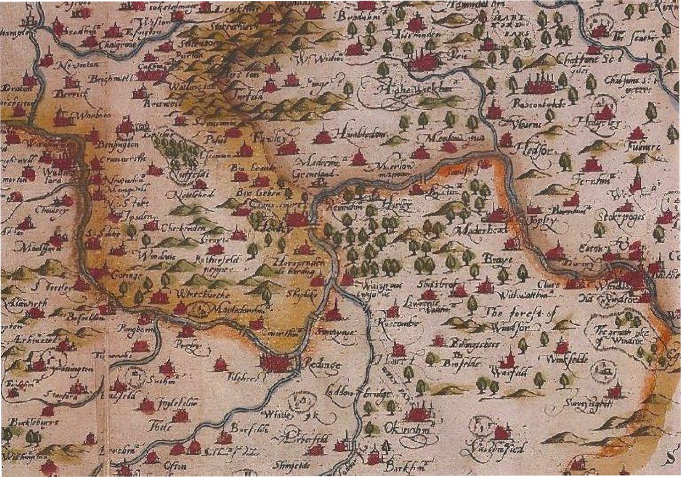
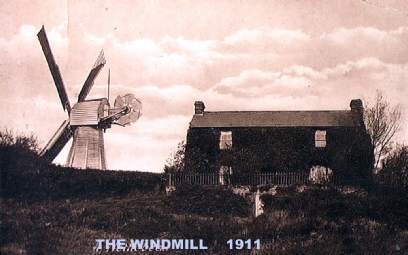
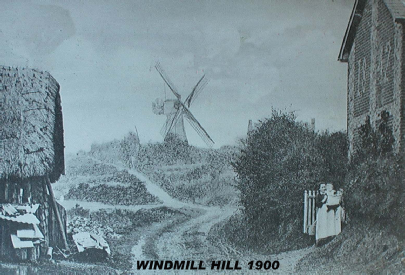
An April night a cloudy sky
A gusty wind that hurried by
The windmill set upon a hill
Stood motionless and stern and still
The wind had ever been it's friend
Had been the motive power to send
It's great arms swinging round so fast
It's very life was in the blast
But now the windmill's life was o'er-
The giant sails revolved no more
Standing upon that hilltop bare
It seemed a winged watch there
To guard the living and the dead
At rest below in Nettlebed
For ninety years the mill had stood
Thro' evil days and of good.
Steadfast alike, thro' storm and rain
Thro' human joy and human pain
Unchanging-
And changes of this mortal life
While man ,how short his time appears
How seldom man lives ninety years
Sudden from out the dusky night
Arose a strange bewildering sight
A lurid flame was seen to glide
Snakelikealong the steep hillside
From tuft to tuft of gorse it spread
Shooting aloft and mounting higher
Until the cry was Fire! Fire!
In haste men climbed the grassy slope
But vain their labour, vain their hope
The roaring flames that crowned the brow
Were wrapped around their windmill now
Flames carried by the wind, it's friend
Were destined thus to be it's end
And miles away the torch was seen –
that flared upon that upland green
And miles away men looked and said
The windmill burns at Nettlebed
Alas this time the raging fire
Became our windmill's funeral pyre
G.E.Spencer (an old Nettlebedite)

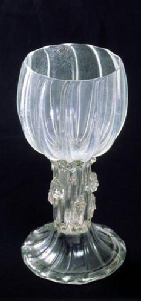
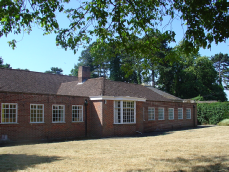
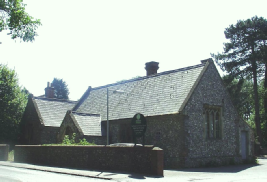
The 1846 school
The 1928 school
now demolished
"she had a School at Nettlebed, Oxfordshire, & kept it a short time after my birth -
Saxton’s map of 1579